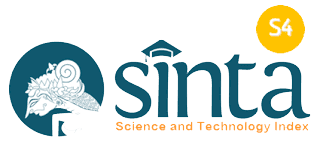Evaluation of the Government's Makassar Recover Program in Makassar City
(1) Departement of administrative Science, Faculty of Social Science and Law, Universitas Negeri Makassar
(2) Departement of administrative Science, Faculty of Social Science and Law, Universitas Negeri Makassar
(3) Departement of administrative Science, Faculty of Social Science and Law, Universitas Negeri Makassar
(4) Department of Civil Engineering and Planning, Faculty of Engineering, Universitas Negeri Makassar
(*) Corresponding Author
DOI: https://doi.org/10.26858/pdr.v6i1.40434
Abstract
This study aims to identify and analyze the Government's Makassar Recover Program in Makassar City, using a qualitative approach. Collecting data using observation techniques, interviews, and documentation. Data obtained from processing results using interactive model analysis including data collection, data condensation, data presentation, and conclusion testing. The results showed that the evaluation of the Makassar Recover program by the Makassar City Government was based on four dimensions including context, input, process, and product, on health immunity, social adaptation, and economic recovery. The context dimension shows that the Makassar Recover program for health immunity and social adaptation is running optimally, but the economic recovery program is showing suboptimal results. The input dimension indicates the availability of human resources and budget. The process dimension shows that the Makassar Recover program is carried out according to standard operating procedures and strict regulations. The product dimension shows that the Makassar Recover program has produced a synergy between the role of the community and the government in overcoming the impact of the Covid-19 virus and social adaptation, but economic recovery has not shown satisfactory results. The determinant factors in this study indicate the existence of strict regulations, resources which include the quality of human resources and budgets, as well as culture in realizing Makassar Recover in Makassar City.
Keywords
Full Text:
PDFReferences
Abdel-Wahab, M., Richardt, G., Joachim Büttner, H., Toelg, R., Geist, V., Meinertz, T., Schofer, J., King, L., Neumann, F.-J., & Khattab, A. A. (2013). High-speed rotational atherectomy before paclitaxel-eluting stent implantation in complex calcified coronary lesions: the randomized ROTAXUS (Rotational Atherectomy Prior to Taxus Stent Treatment for Complex Native Coronary Artery Disease) trial. JACC: Cardiovascular Interventions, 6(1), 10–19.
Cheng, X., Long, R., Chen, H., & Li, Q. (2019). Coupling coordination degree and spatial dynamic evolution of a regional green competitiveness system – A case study from China. Ecological Indicators, 104, 489–500. https://doi.org/https://doi.org/10.1016/j.ecolind.2019.04.003
Choi, T. Y., Rogers, D., & Vakil, B. (2020). Coronavirus is a wake-up call for supply chain management. Harvard Business Review, 27(1), 364–398.
Creswell, J. W. (1999). Mixed-method research: Introduction and application. In Handbook of educational policy (hal. 455–472). Elsevier.
Creswell, J. W. (2010). Mapping the developing landscape of mixed methods research. SAGE handbook of mixed methods in social & behavioral research, 2, 45–68.
Creswell, J. W., & Clark, V. L. P. (2017). Designing and conducting mixed methods research. Sage publications.
Creswell, J. W., & Creswell, J. D. (2017). Research design: Qualitative, quantitative, and mixed methods approaches. Sage publications.
Daraba, D., Wirawan, H., Salam, R., & Faisal, M. (2021). Working from home during the corona pandemic: Investigating the role of authentic leadership, psychological capital, and gender on employee performance. Cogent Business & Management, 8(1), 1885573.
Fetters, M. D., Curry, L. A., & Creswell, J. W. (2013). Achieving integration in mixed methods designs—principles and practices. Health services research, 48(6pt2), 2134–2156.
Ishikura, T. (2020). Regional economic effects of transport infrastructure development featuring trade gateway region-asymmetric spatial CGE model approach. Transportation Research Procedia, 48, 1750–1765. https://doi.org/https://doi.org/10.1016/j.trpro.2020.08.211
John W Creswell. (2013). Research Design Pendekatan Kualitatif, Kuantitatif, dan Mixed (Tiga). Pustaka Pelajar.
Liu, J., Tian, Y., Huang, K., & Yi, T. (2021). Spatial-temporal differentiation of the coupling coordinated development of regional energy-economy-ecology system: A case study of the Yangtze River Economic Belt. Ecological Indicators, 124, 107394. https://doi.org/https://doi.org/10.1016/j.ecolind.2021.107394
Lyu, Y., Peng, Y., Liu, H., & Hwang, J.-J. (2022). Impact of Digital Economy on the Provision Efficiency for Public Health Services: Empirical Study of 31 Provinces in China. International Journal of Environmental Research and Public Health, 19(10), 5978. https://doi.org/10.3390/ijerph19105978
Paules, C. I. (2020). Coronavirus Infections — More Than Just the Common Cold. 2520, 1–2. https://doi.org/10.1007/82
Schmutz, A. M. S., Jenkins, L. S., Coetzee, F., Conradie, H., Irlam, J., Joubert, E. M., Matthews, D., & van Schalkwyk, S. C. (2021). Re-imagining health professions education in the coronavirus disease 2019 era: Perspectives from South Africa. African Journal of Primary Health Care & Family Medicine, 13(1), 2948. https://doi.org/10.4102/phcfm.v13i1.2948
Tang, L. (2022). Study on Coupling Coordination Degree between Regional Sports Industry Development and Healthy China Construction. Journal of Healthcare Engineering, 2022, 7785267. https://doi.org/10.1155/2022/7785267
Zhang, J., Zhao, W., Cheng, B., Li, A., Wang, Y., Yang, N., & Tian, Y. (2022). The Impact of Digital Economy on the Economic Growth and the Development Strategies in the post-COVID-19 Era: Evidence From Countries Along the “Belt and Road.” Frontiers in Public Health, 10, 856142. https://doi.org/10.3389/fpubh.2022.856142
Article Metrics
Abstract view : 83 times | PDF view : 25 timesRefbacks
- There are currently no refbacks.
Copyright (c) 2022 Didin Halim, Herlina Sakawati, Triyani Setiawan


































